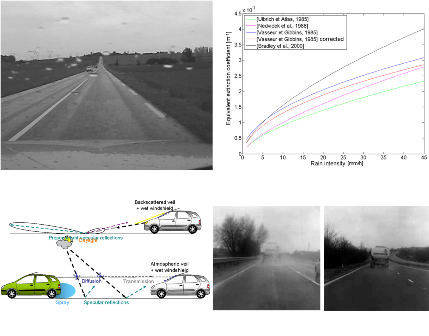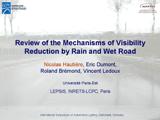| In this paper, we review the mechanisms which lead to road visibility reduction due to rain and water projections based on the existing scientific literature. Reported works deal with atmospheric optics, vision as well as human factors. We classify the visual effects of rain on road visibility within three main categories. The first category deals with the scattering of light by rain drops. At this step, a quantitative comparison is made with the visual effects of fog on the road visibility. The second category is concerned with the effects of water
projections, generally known as the “splash and spray” effect. On the one hand, we have the effect of rain falling on the windshield. On the other hand, we have the water projections
caused by other vehicles. The third category deals with wet road surfaces, in particular the road markings whose appearance is changing with the water layer on the pavement. So far,the reduction of visibility induced by the rain or the water projections is a combination of these three categories of effects. One may guess that in most cases, the effects of the first category can be neglected with respect to the two other categories. To conclude, rain affects road visibility due to falling or splashed water which cause contrast reduction, and due to the
film of water on the pavement and other road surfaces which not only reduces contrast but also adds glare, especially at night as it impairs the efficiency of the driver’s headlights. A
first perspective of this work consists in synthesizing an in-vehicle indicator related to the visibility reduction in rainy weather, which could lead to safety speed recommendations or a
novel criterion to assess the efficiency of wipers. A second perspective consists in achieving
photometrical simulations of the visual effects of rain on the road visibility based on the proposed models and to rank them, as it was already done for the fog. |



